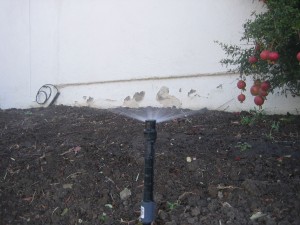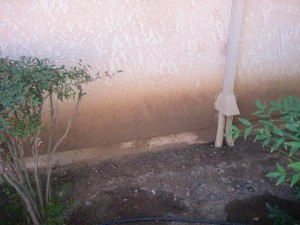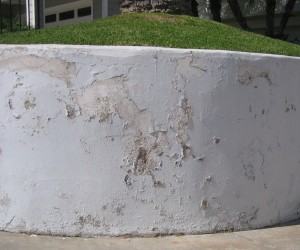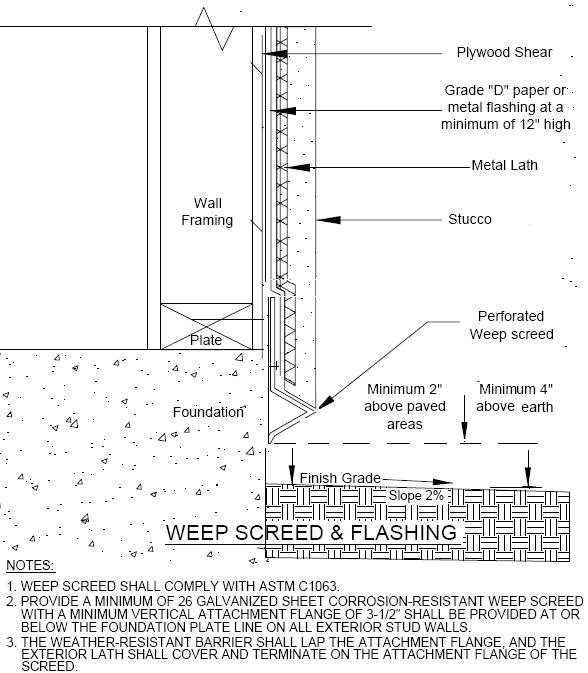If you live in an older stucco home that is painted or have block planters coated with stucco then you probably have seen bubbling, blistering or peeling stucco. What are the causes of damaged stucco? How can it be prevented? This article covers the common types of water damage and their causes. Identifying the type and cause can be very helpful in putting together a prevention plan.
Water Damaged Stucco – Types
Water damage to stucco can be seen in the following forms:
Staining
Most water damage to stucco is first observed as staining. Since stucco turns darker when wet staining can remain after stucco dries. Staining can be seen as either white hazy streaks or as dark blotches in the color. Staining is your first indication of water problems and if not addressed can result in efflorescence and blistering.
Efflorescence
Efflorescence usually occurs immediately after staining. Efflorescence is a white crystalline, powdery or often fluffy/fuzzy deposit on the surface of masonry materials like concrete, brick, clay tile and in this case plaster. It’s caused by water seeping through the stucco wall. The water dissolves salts as it moves through the wall and then evaporates leaving the expanding salts on the surface. Efflorescence is often the root cause of blistering.
Blistering
When a wall is subjected to large amounts of water for long periods of time, efflorescence can result. Efflorescence can lead to blistering due to salts expanding or being trapped behind the surface. This is especially the case when stucco is painted. In extreme cases there will be areas where the finish coat or sometimes even the base coat will blister and delaminate from the wall.
Mold
Mold can result from stucco remaining damp and out of sunlight for long periods of time. Mold can be observed as a green film or a black stain on the surface of stucco. Although surface mold can usually be treated and removed rather easily it is better to address the cause of mold by protecting stucco from moisture.
Water Damaged Stucco – Causes
As mentioned all of these problems have one common source… Water. To prevent damage to stucco water needs to be effectively managed. Unfortunately many architects, contractors or homeowners have not taken adequate measures to manage and direct water away from stucco.
There are basically three ways stucco can be damaged by water.
- Surface Moisture – Stucco subjected to water hitting or running down the surface
- Hydraulic Pressure – water migration from behind the stucco
- Wicking – Plaster in contact with dirt or concrete causing water to be absorbed from the ground
Stucco Damaged by Surface Moisture
The 2 most common ways stucco can be damaged by surface moisture is:
1) Improperly placed and adjusted irrigation sprinklers
This is a common problem. Often times planters are placed adjacent to stucco walls and the sprinklers are placed at the outer perimeter shooting water in towards the house or stucco wall. In many cases the sprinklers are not adjusted properly causing water to spray over or past plants and directly onto the stucco.
Due to the excessive exposure to moisture the stucco stains, effloresces and or blisters. Worse yet sometimes the paper moisture barrier behind the stucco becomes brittle and fails which can lead to mold and structural damage.
These problems can be eliminated by either not planting against your home or taking strict measures to keep irrigation water off your stucco.
2) No gutters or improperly flashed roofs or balconies
Some cases homes are not equipped with gutters or troughs that direct water away from the house. In many cases during rain, water either runs down the face of the stucco or falls directly to the ground and splashes against the house. One tell-tale symptom of this problem is dirty stucco along the base of your house in areas where you have planters.
Installing proper drip edge metal, gutters and downspouts will help manage roof water. In some cases homeowners have installed special landscape material such as rock or wood chips in areas directly below their eves to aide in preventing water from splashing against stucco.
Stucco Damaged by Water Migration “Through” Walls
This type of damage to stucco is usually evident in retaining walls. Exposing block walls to water from behind the wall will eventually result in efflorescence on the surface or base of wall.
Extreme efflorescence causes blistering due to salts being trapped behind the surface. Although blistering is sometimes observed with unpainted walls it always occurs with painted walls. Therefore painting retaining walls is highly discouraged and doing so will lead to regular maintenance. The best way to eliminate this type of problem is to create a moisture barrier behind the retaining wall along with good drainage. Painting should be avoided to prevent unsightly blistering and costly ongoing maintenance.
Stucco Damaged by Wicking
“Wicking” is often a result of improper use of weep screed.
- Weep Screed not Used
Weep screed was typically not used on houses built back in the 50’s and 60’s. Although weep screed first appeared in ASTM handbooks in the early 90’s it had already been in use since the 70’s. The purpose of weep screed is to allow water that penetrates a stucco surface to run down the wall between the stucco and moisture barrier and escape through weep holes in the screed. If no weep screed is installed water cannot escape through the base of the wall and if the wall is plastered all the way to the ground moisture can actually “wick” up the wall. Moisture damage from wicking can result in staining, efflorescence and blistering.
- Weep Screed not Installed Correctly
In order for weep screed to work it needs to be installed correctly. New local building codes in California require weep screed to be installed 2” above a concrete or finished surface and 6” above dirt, grass or stone (earth). Weep screed should have at least a 3 ½” flange and is typically installed flush with the top of the horizontal stud or plate at the base of a wall. This allows for the flange to serve as a flashing to prevent moisture from wicking up behind the weep screed and gaining entrance into the wall.
- Weep Screed Ignored
I have seen instances where homeowners have ignored the role of weep screed and either poured concrete against or built planters too high and have buried weep screed. Burying weep screed usually results in moisture eventually coming into the home, causing water and possibly leading to mold growth.
Preventing water damage to stucco is a result of good planning and building practices. Although stucco can withstand some water, constant exposure over time will result in costly problems. As a homeowner good observation and making sure water is effectively diverted away from your home will help keep your stucco free from water damage.
Thom Susko is a 30 yr plastering veteran and the Managing Partner of The Home Plaster Shop in San Clemente, California. He can be contacted by visiting his company website at www.homeplaster.com.




